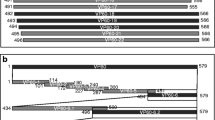Abstract
Balb/С mice were immunized with recombinant Ebola virus glycoprotein. Following the selection, screening, and cloning of murine hybridomas, we obtained five genetically stable clones of monoclonal antibodies GPE118 (IgG), GPE274 (IgM), GPE325 (IgM), GPE463 (IgM), and GPE534 (IgG). These antibodies were isolated and purified from the ascitic fluid of Balb/С mice using Protein G affinity chromatography (for IgG) and euglobulin precipitation (for IgM). To select at least three candidate antibodies for testing in biological assays as components of an antibody cocktail for the prophylaxis and treatment of hemorrhagic fever, we carried out an immunochemical analysis of the epitope specificity of the isolated antibodies. Based on the data of immunoblotting and sandwich ELISA, it became evident that the epitope recognized by GPE 534 differs from the epitopes recognized by the monoclonal antibodies GPE 118 and GPE 325. The last two antibodies also have different epitope specificity: it follows from the immunoblotting data and from the data on the binding of these antibodies with the intact and oxidized (partly deglycosylated) recombinant glycoprotein. For the biological activity studies and the development of recombinant counterparts, we selected three candidate high-affinity monoclonal antibodies GPE 534, GPE 118, and GPE 325.
Similar content being viewed by others
References
Baize, S., Pannetier, D., Oestereich, L., et al., Emergence of Zaire Ebola virus disease in Guinea, N. Engl. J. Med., 2014, vol. 371, no. 15, pp. 1418–1425.
Geisbert, T.W., Young, H.A., Jahrling, P.B., Davis, K.J., Kagan, E., and Hensley, L.E., Mechanisms underlying coagulation abnormalities in ebola hemorrhagic fever: overexpression of tissue factor in primate monocytes/macrophages is a key event, J. Infect. Dis., 2003, vol. 188, no. 11, pp. 1618–1629.
Geisbert, T.W., Hensley, L.E., Jahrling, P.B., Larsen, T., Geisbert, J.B., Paragas, J., Young, H.A., Fredeking, T.M., Rote, W.E., and Vlasuk, G.P., Treatment of ebola virus infection with a recombinant inhibitor of factor VIIa/tissue factor: a study in rhesus monkeys, Lancet, 2003, vol. 362, no. 9400, pp. 1953–1958.
Warren, T.K., Warfield, K.L., Wells, J., Swenson, D.L., Donner, K.S., Van Tongeren, S.A., Garza, N.L., Dong, L., Mourich, D.V., Crumley, S., Nichols, D.K., Iversen, P.L., and Bavari, S., Advanced antisense therapies for postexposure protection against lethal filovirus infections, Nat. Med., 2010, vol. 16, no. 9, pp. 991–994.
Volchkov, V.E., Feldmann, H., Volchkova, V.A., and Klenk, H.D., Processing of the Ebola virus glycoprotein by the proprotein convertase furin, Proc. Natl. Acad. Sci. U. S. A., 1998, vol. 95, no. 10, pp. 5762–5767.
Lee, J.E. and Saphire, EO., Ebolavirus glycoprotein structure and mechanism of entry, Future Virol., 2009, vol. 4, no. 6, pp. 621–635.
Jahrling, P.B., Geisbert, J.B., Swearengen, J.R., Larsen, T., and Geisbert, T.W., Ebola hemorrhagic fever: evaluation of passive immunotherapy in nonhuman primates, J. Infect. Dis., 2007, vol. 196, no. 2, pp. 400–S403.
Parren, P.W., Geisbert, T.W., Maruyama, T., Jahrling, P.B., and Burton, D.R., Pre-and postexposure prophylaxis of Ebola virus infection in an animal model by passive transfer of a neutralizing human antibody, J. Virol., 2002, vol. 76, no. 12, pp. 6408–6412.
Oswald, W.B., Geisbert, T.W., Davis, K.J., Geisbert, J.B., Sullivan, N.J., Jahrling, P.B., Parren, P.W., and Burton, D.R., Neutralizing antibody fails to impact the course of Ebola virus infection in monkeys, PLoS Pathog., 2007, vol. 3, no. 1, p. e9.
Olinger, G.G., Pettitt, J., Kim, D., et al., Delayed treatment of Ebola virus infection with plant-derived monoclonal antibodies provides protection in rhesus macaques, Proc. Natl. Acad. Sci. U. S. A., 2012, vol. 109, no. 44, pp. 18030–18035.
Qiu, X., Audet, J., Wong, G., et al., Successful treatment of Ebola virus-infected cynomolgus macaques with monoclonal antibodies, Sci. Transl. Med., 2012, vol. 4, no. 138, p. 138ra81
Qiu, X., Wong, G., Audet, J., et al., Reversion of advanced Ebola virus disease in nonhuman primates with Zmapp, Nature, 2014, vol. 514, no. 7520, pp. 47–53.
Sveshnikov, P. and Kiselev, V., Russian Patent PCT/RU2004/000373, 2004.
Kohler, G. and Milstein, C., Continuous cultures of fused cells secreting antibody of predefined specificity, Nature, 1975, vol. 256, no. 5517, pp. 495–497.
García-González, M., Bettinger, S., Ott, S., Olivier, P., Kadouche, J., and Pouletty, P., Purification of murine IgG3 and igM monoclonal antibodies by euglobulin precipitation, J. Immunol. Methods, 1988, vol. 111, no. 1, pp. 17–23.
Westwood, J. and Thomas, P., Studies on the structure and immunological activity of carcinoembryonic antigen—the role of disulphide bonds, Br. J. Cancer, 1975, vol. 32, no. 6, p. 708–719.
Nakane, P.K. and Kawaoi, A., Peroxidase-labeled antibody. A new method of conjugation, J. Histochem. Cytochem., 1974, vol. 22, no. 12, pp. 1084–1091.
Ponomarenko, J., Vaughan, K., Sette, A., and Maurer-Stroh, S., Conservancy of mAb epitopes in Ebolavirus glycoproteins of previous and 2014 outbreaks, PloS Curr., 2014, vol. 6.
Author information
Authors and Affiliations
Corresponding author
Additional information
Original Russian Text © O.B. Schemchukova, I.G. Dement’yeva, N.E. Varlamov, L.P. Pozdnyakova, M.N. Bokov, T.K. Aliev, A.A. Panina, D.A. Dolgikh, M.P. Kirpichnikov, P.G. Sveshnikov, 2016, published in Vestnik Moskovskogo Universiteta. Biologiya, 2016, No. 1, pp. 29–34.
About this article
Cite this article
Schemchukova, O.B., Dement’yeva, I.G., Varlamov, N.E. et al. Development and characterization of monoclonal antibodies to Ebola virus glycoprotein. Moscow Univ. Biol.Sci. Bull. 71, 24–28 (2016). https://doi.org/10.3103/S0096392516010090
Received:
Published:
Issue Date:
DOI: https://doi.org/10.3103/S0096392516010090



